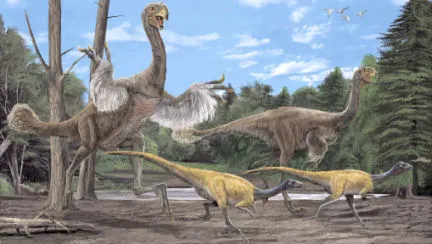Big and Birdlike: Chinese dinosaur was 3.5 meters tall
Paleontologists have unearthed the remains of an immense, fast-growing dinosaur whose body proportions don’t match those predicted by the evolutionary trends that characterize its more diminutive kin.

The creature, one of a group of birdlike dinosaurs called oviraptors, strolled semiarid river valleys of what is now northern China about 70 million years ago. Aptly given the genus name Gigantoraptor, it stood 3.5 meters tall at its shoulder, measured about 8 m long, and probably tipped the scales at about 1.4 metric tons. Other oviraptors weighed no more than 40 kilograms, says Xing Xu of the Institute of Vertebrate Paleontology and Paleoanthropology in Beijing.
Xu and his colleagues recovered most of the creature’s limb and tail bones as well as partial remains of its lower jaw and spinal column. When the researchers excavated the first of the creature’s enormous bones in April 2005, says Xu, “we first thought it might be from a sauropod,” one of the colossal, long-necked dinosaurs that lived in the region at the same time. “Then we thought it might be from a tyrannosaur,” he notes.
Characteristics of a variety of bones excavated later indicated that the creature was a bizarre new species, which the team describes in the June 14 Nature.
Although the fossils didn’t preserve any hints of feathers, Xu speculates that the creature might nevertheless have sported some because many of its smaller relatives did.
The number and spacing of growth rings in one of the creature’s leg bones suggest that the dinosaur was about 11 years old when it died. A large number of microstructures produced by a certain kind of mature bone cell indicate that this Gigantoraptor was a young adult, says Xu. However, the wide spacing of the last four growth rings recorded in the dense, outermost layer of the bone hints that the creature was still growing at the time of its demise, he notes.
Gigantoraptors grew much faster and reached adulthood more quickly than did tyrannosaurs, says Thomas R. Holtz Jr., a vertebrate paleontologist at the University of Maryland at College Park. “There was an incentive [for such a creature] to get big really soon” as a defense against predators such as tyrannosaurs, whose remains have been found in the same sediments, he notes.
The length and proportions of Gigantoraptor’s leg bones hint at another of the dinosaur’s survival skills—its running speed—says Holtz. It “would have been among the fastest dinosaurs of its body size,” he speculates.
Among most dinosaurs in the lineage that includes birds, a large body size typically correlates with anatomical features that are less birdlike—including short, stout limbs with relatively short lower-leg bones. Gigantoraptor is a big exception to that evolutionary pattern, “so it’s really a surprising discovery,” says Xu.
“This is one weird dinosaur,” agrees Holtz.







